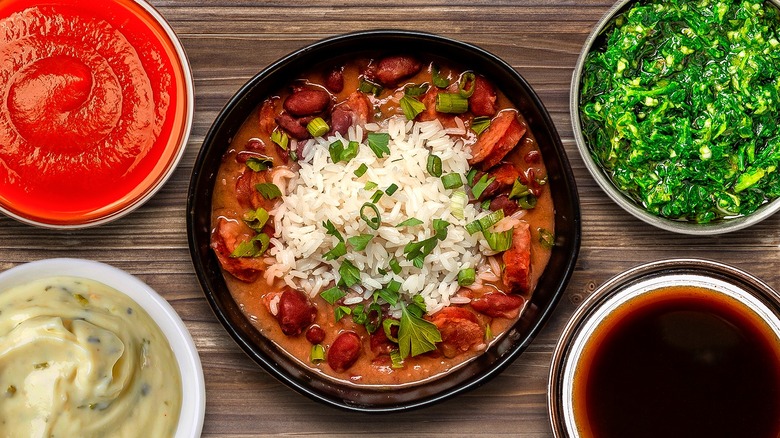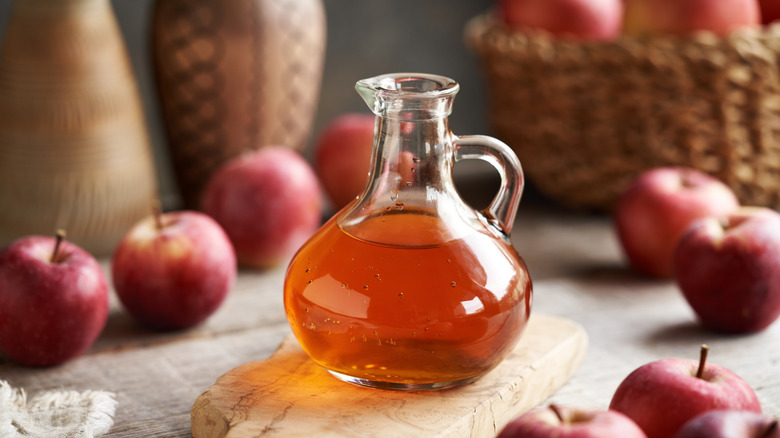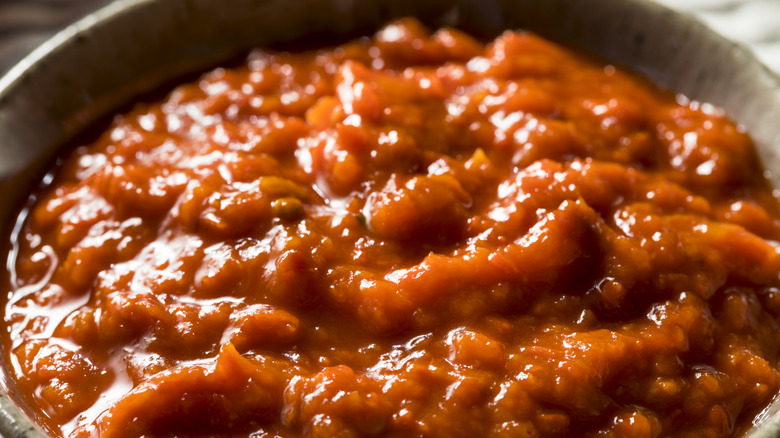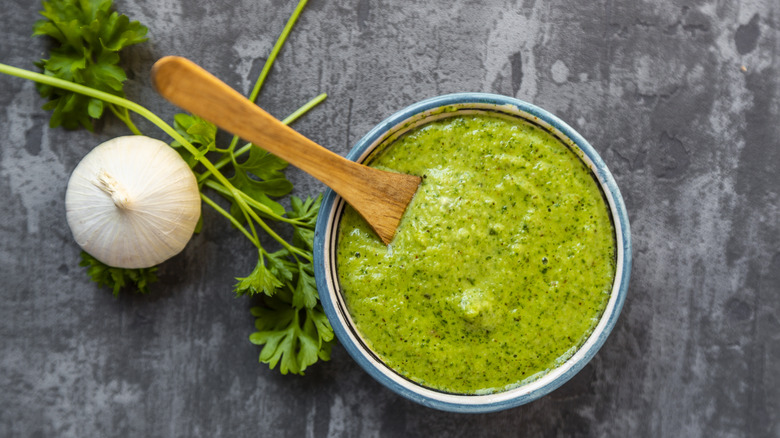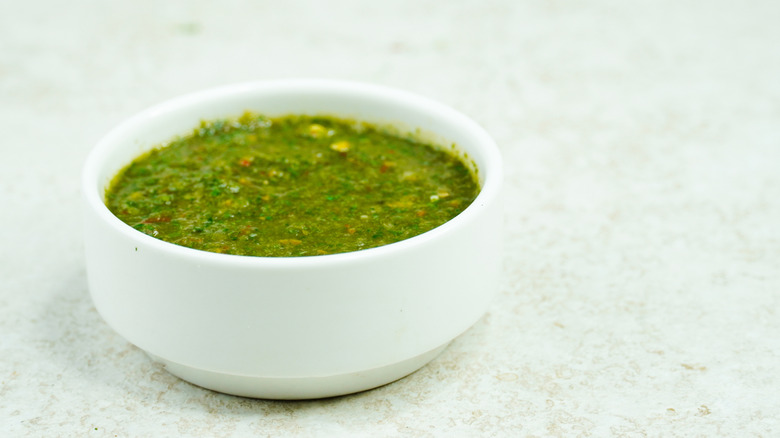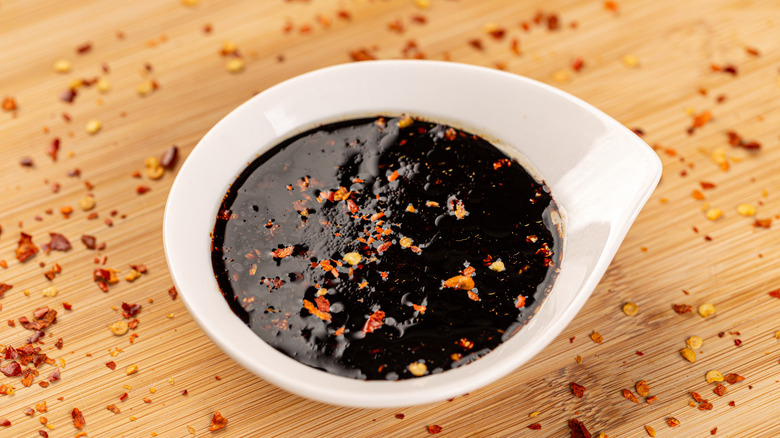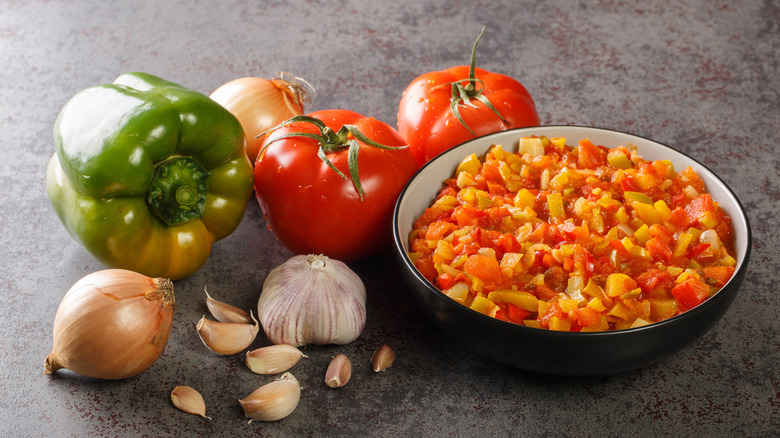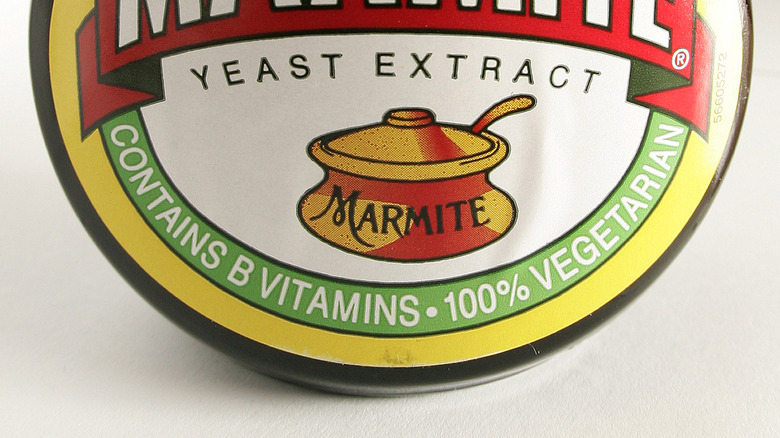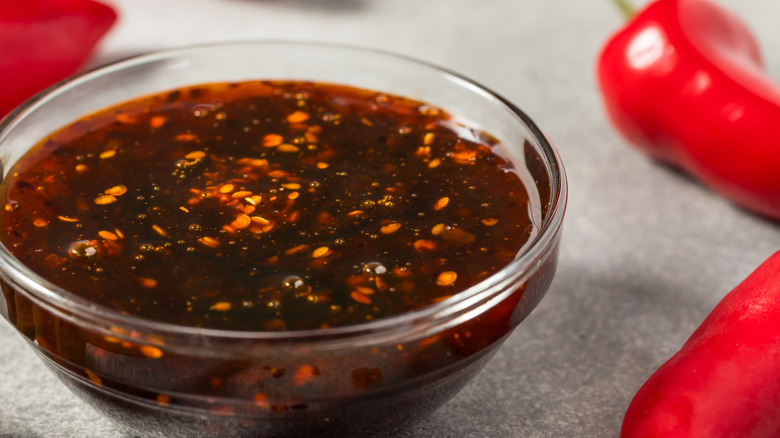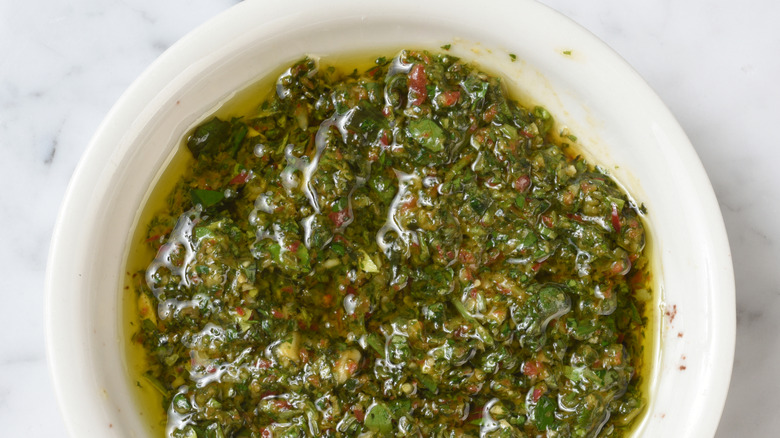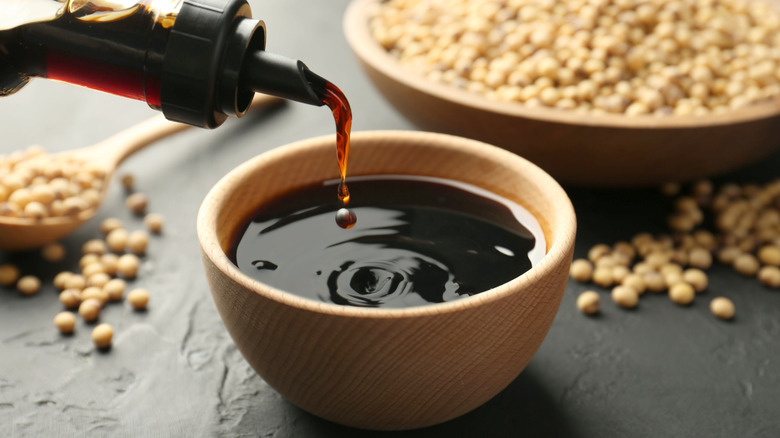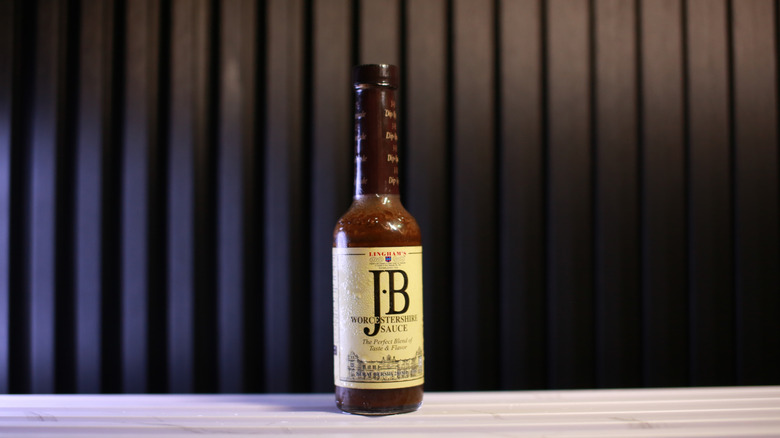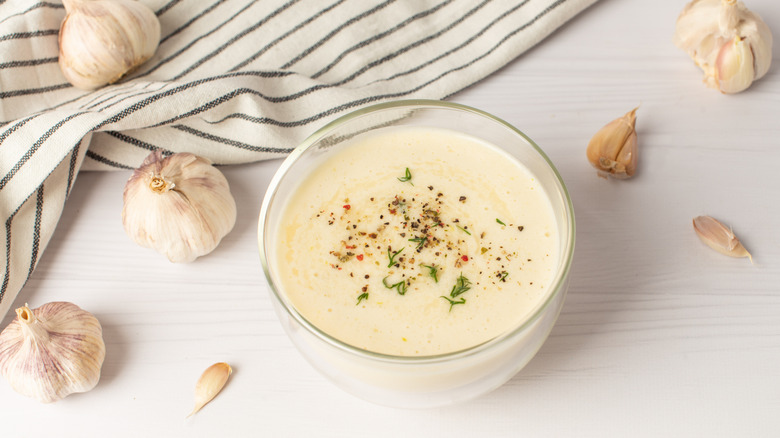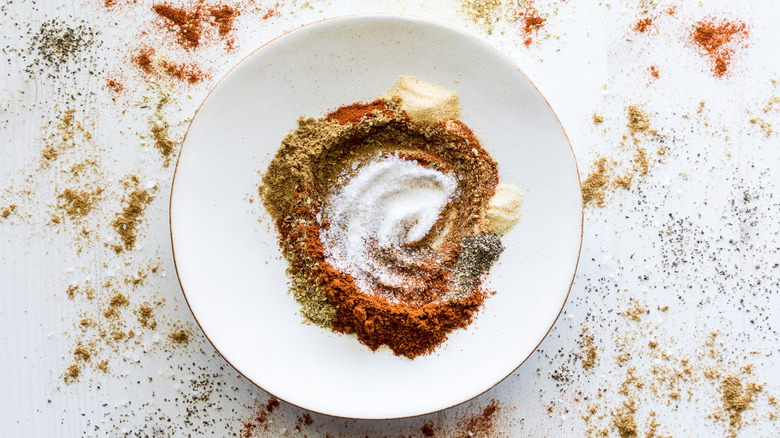The 14 Ingredients You Need To Level Up Rice And Beans
We may receive a commission on purchases made from links.
When times are tough, you may have to cut back on your favorite splurge items at the grocery store. Luckily, there is a food combination that is inexpensive, healthy, and delicious. It's beloved across cultures and stands the test of time. It can be a main course or side dish and is easily dressed up using spices and sauces. Say hello to your old favorite dynamic duo: rice and beans. I guess you don't have to introduce yourself, as you've likely enjoyed this hearty, filling, and starchy combo many times throughout your life. And although it doesn't wreak "gourmet," there are a few simple ingredients you can use to upgrade your rice and beans. This can help create variety if you intend to enjoy them more than once a week. You can also experiment with spices and sauces from different cultural cuisines.
As a plant-based chef and recipe designer with a Cornell certification in plant-based nutrition, I enjoy lengthy, complex recipes with ingredients I can hardly pronounce. However, nobody has endless time on their hands or an endless budget, so rice and beans make it into my diet on a weekly basis, if not more often. Don't get me wrong. I would never dare eat plain rice and beans. When it comes to any base, it's all about the flavor, so it's time to explore some simple ingredients to upgrade this healthy and classic combination.
Vinegar
If you've created your own dish, and it tastes like something is still missing, it's likely because you've not included each of the following: something salty, something sweet, something acidic, and something fatty. That's right, even a smoothie does well with a pinch of salt and a squeeze of lemon. Just the tiniest hint of an ingredient from each of those four categories creates a balanced mouthfeel. Most of the time, if something is missing from your dish, it's acidity. Citrus fruits and vinegar are great ways to include acidity in a dish. To boost your rice and beans, we recommend a splash of vinegar.
Vinegar is a very common ingredient for rice seasoning, along with a little sugar and salt, so it's no stranger to the grain. Use just a small splash of apple cider vinegar in your rice and beans to elevate the flavor. It can help to temper bitter flavors and can actually make us even more sensitive to salt. This is why you should always taste your food after adding vinegar and before adding extra salt.
Harissa
Rice and beans are enjoyed across cultures as a staple, and North Africa and the Middle East are no exception. An ingredient that's very popular in that region is harissa. So, of course, this sauce and the starchy duo are a match made in heaven. Harissa is becoming more popular in the United States, so you are likely to find it jarred in your store's ethnic food aisle or at a specialty market. You can find it easily in an African or Middle Eastern market or even online.
Transform rice and beans with this simple ingredient, and spend less time prepping dinner and more time doing what you love. You will be amazed by the myriad of flavors and the warming heat produced by the chilis.
Harissa is made with roasted red peppers, hot chili peppers, garlic paste, olive oil, herbs, and spices. It is sweet from the red peppers but spicy from the chili peppers. It's highly aromatic, with an intensity of flavor brought on by the strong notes of caraway seeds, cumin, and coriander. By adding salt, fat, and spice, the flavor of your rice and beans will be much more rounded. Consider smearing harissa sauce on top of the cooked rice and beans or mixing it right in.
Schug
Schug, also known as zhug, is a Yemeni hot sauce that is powerful beyond the heat of the chilis. Although it looks a bit like chimichurri in appearance, schug has its own unique flavor profile. Using green hot peppers — typically jalapeños — as a base, along with cilantro, parsley, and garlic, this sauce leaves room for experimentation with the spices. However, cumin, black pepper, caraway seeds, coriander, and cardamom are typical in a schug recipe and leave a deep and rounded flavor lingering on the tongue. The acidity from lemon juice and the fat from the olive oil help to elevate the spices and bring everything together. Schug works particularly well with rice and beans because it's bold, with a range of flavors hitting almost every category.
Enjoy it over white rice and black, pinto, or kidney beans. This recipe for schug is your secret weapon to make even the most bland dishes pop. It's quite hot, so start with just a little bit, then load it on to your liking. Find schug in the ethnic food aisle, in a Middle Eastern grocery store, or online, or locate the spice mix in the spice aisle. Spice lovers won't be able to stop eating this bold and tangy hot sauce.
Coriander chutney
Cilantro is an herb that was born to elevate rice and beans. It is fresh-tasting and grassy and has a citrus-like kick. However, some people are biologically repulsed by cilantro. It's not their fault, though. The reason some people think cilantro tastes like soap is because of their genetics. If this happens to you, avoid coriander chutney at all costs. Swad makes a very pleasing coriander chutney that is accessible in some grocery stores and most Indian and Asian markets. It's typically made with coriander (cilantro), peppers, coconut, and spices. The coconut makes it creamy and melts beautifully over hot rice and beans.
Although this chutney originates in India, it is a great addition to Mexican-style rice and beans. You could also enjoy traditional green chutney over hot white rice and chickpeas. Coriander chutney delivers the perfect balance of sweet, spicy, and fatty to give your rice and beans some flavor.
Japanese barbecue sauce
Although rice and beans typically conjure up images of white rice and black beans, that doesn't mean you must always stick with the norm. In fact, it's better to expand your horizons and test your culinary creativity. Use brown rice and edamame, a Japanese-style rice and beans dish, and top it with Bachan's Japanese barbecue sauce. This sauce is often used over Japanese short ribs, stir fry or even pan-fried tofu, but we think it does its best work when rice is involved so it can soak into the soft bed of starchy deliciousness.
Japanese barbecue sauce has strong umami flavors, alongside intense saltiness, acidity, and sweet notes, hitting every flavor profile. Bachan's Japanese Barbecue Sauce has a lot of different uses, but it does a particularly good job of creating a universally loved sauce that's umami-rich but not too intense and works wonders over rice and beans. Enjoying Mexican rice and beans one night couldn't be more different than experimenting with the Japanese version the next. You'll feel like you've entered a Japanese steakhouse with one simple squirt of this pre-made sauce. It doesn't get much easier than that.
Sofrito
Yes, salsa is a classic ingredient to enjoy with rice and beans, but let's dive a little deeper and find something made to be an ingredient, not a condiment, with a similar flavor profile. Sofrito has that classic tomato, onion, pepper, and herb flavoring, but it is cooked and pureed, making it the ideal ingredient to boost rice and beans. Use white, wild, or brown rice with black beans for a classic, or try kidney beans for something a bit meatier.
Sofrito is relatively easy to find in the Mexican foods section of most grocery stores. It ranges from mild to spicy depending on the peppers used. Because it's traditionally braised or cooked over low heat for an extended period of time, sofrito is less acidic than salsa, which is typically eaten raw. As the tomatoes cook in sofrito, they sweeten just like they would in a slow-cooked marinara sauce. Because of the range of ingredients, sofrito ends up looking as if green and red salsa were mixed, with little bits of color as if sprinkled with confetti. Forgot to grab a jar from the grocery store? Don't fear, as you can use this simple sofrito recipe at home to upgrade your rice and beans.
Marmite
'Ello chaps! From across the pond, there is a condiment that is controversial. While English folks might keep a jar of Marmite yeast extract on hand at all times, outsiders may find it to be a little out of their element. Marmite is rich with umami flavors, it's salty, and it's loaded with vegetable undertones similar to those found in veggie broth or bouillon. It can be used as both an ingredient and as a condiment, but for the application of rice and beans, I recommend mixing it in during the cooking process. This is because Marmite is very strong in flavor and does best when evenly distributed in a dish unless, of course, you're a Marmite monger who could eat it right out of the jar.
Umami is the fifth flavor and extremely important to creating a meaty depth and rounded mouthfeel. It's deeply savory, so adding a umami-loaded ingredient like Marmite to your rice and beans can only enhance it. This is why Marmite is essential for every home pantry. It's the perfect ingredient to give any dish that extra layer of flavor it's lacking. Simply use a small amount of Marmite in the water that you boil your rice in, or mix it right into your simmering beans. You can use it with any form of rice and any variety of beans without clashing flavors. There's no need to use salt when Marmite is called into play.
Chili crunch oil
If you have yet to discover the wonders of chili crunch oil, then skedaddle on down to your local market and grab yourself a jar asap. For those new to the chili crunch scene, this irresistible crunchy, crispy oil is loaded with chilis, garlic, and onion. Note that there is a slight textural difference between chili crunch and chili crisp — chili crunch sometimes has sesame seeds or chopped peanuts to add a chewiness to the "crunch" aspect. However, the flavor doesn't vary greatly. There are endless brands, so experiment with a few before claiming your favorite. Trader Joe's has a reliable chili crunch oil beloved by many. Tasting Table has ranked more than a dozen chili crisps and found the best to be manufactured by Bullet.
Simply drizzle the oil over your rice and beans, or stir the jar first to include all of the crunchy bits. You can use it in the cooking process or use it to decorate the rice and beans once they're done. The peppers' red coloring will dye your white rice, making it aesthetically pleasing while adding texture via the bits and pieces. Both chili crisp and chili crunch are incredible options to upgrade your rice and beans.
Chimichurri
Even if you live under a rock, most people have heard of chimichurri before. However, that doesn't mean that we are all well-versed in its flavors and ingredients. Chimichurri is a deeply herby oil-based sauce originating from Argentina. It can be used as a marinade, condiment, dressing, or sauce. It's typically a fresh bright green color from the minced parsley, with specs of red from the chopped red chilis. Vinegar and olive oil account for the bulk of the liquid, and garlic and oregano help to bring it to light, alongside salt. It's very fresh, spicy, grassy, and slightly citrusy. If you like parsley, this is your sauce.
Simply spoon jarred chimichurri over your rice and beans. The oil will help to create a round mouthfeel, while the salt and vinegar will elevate those flavors, helping them to reach their full potential. Although several brands carry the sauce premade, I would recommend hunting for a local distributor at a market or farmers market, as it's an uncooked sauce and is best eaten fresh. This is one of those types of green sauces that you have to try at least once, and I can assure you it won't be your last time. Chimichurri is a simple ingredient that can upgrade your rice and beans instantly.
Tamari
Salt is so yesterday. Yes, we know that salt works wonders elevating the existing flavors of a dish. But there are more creative ways to sneak sodium into the equation while also adding layers of flavor. Tamari and soy sauce are both great options. Not only is tamari deeply salty, but it's rich with deep, meaty umami flavors. It's made from fermented soybeans and fermented koji, which give it that ultra-savory flavor. Replacing salt in a dish with the condiment is one of the best uses for tamari. I would highly recommend using a splash or two to flavor both your rice and your beans.
The beauty of tamari, which is simply a gluten-free version of soy sauce, is that it goes with any savory ingredient. Either cook it right into your rice water and simmering beans, or use it as a condiment to flavor them once plated. Use on any cuisine from Mexican, to Asian, to North American, to East African.
Worcestershire
Even if you can't pronounce it, Worcestershire sauce is a condiment that you likely have tucked in your refrigerator door. It's unique because it carries both umami and light acidic flavors. It's a unique combination of malt barley extract, anchovies, sugar, salt, molasses, vinegar, shallots, garlic, and spices that makes for an umami-rich, tangy sauce with soft sweet undertones that can help to round out any dish. Try using it with your rice and beans. Worcestershire sauce goes one step beyond vinegar or tamari because it incorporates both flavors and more. For all you vegetarians and vegans, take note that there are plenty of vegan Worcestershire brands that don't use anchovies.
I recommend using Worcestershire sauce with a meatier rice and bean combination. Perhaps brown, red, or black rice in combination with kidney beans. This will help to parallel the meatiness from the umami and create a hearty dish that will last you all day long. Splash it into the cooking rice and beans, or splash it over the combo once it is served. Worcestershire sauce can certainly elevate your meals in any number of ways, so keep it on hand for your rice and beans.
Sriracha
Let's be honest. Most of us have a bottle of sriracha in our refrigerator, and that bottle gets used often. However, ever since sriracha has been difficult to find, we've had to find alternatives, and most of them aren't that bad. Whether you're using the real stuff, or an off-brand sriracha-style hot sauce, the basic flavor profile is relatively similar, and it gets the job done. Beyond the heat from the peppers, sriracha contains vinegar, sugar, garlic, and spices, similar to most hot sauces. However, it is thicker and meatier, and it has a special something that has helped to elevate the brand to the top.
Squeeze a trail of sriracha over your rice and beans to upgrade it. It's an easily accessible sauce that can make all the difference. The addition of the spicy garlic and peppers will help to excite the tongue, increasing salivation, and therefore increasing your sensory experience. If the heat is too much for you, consider mixing it with a little mayonnaise before drizzling it over your cooked rice and beans.
Aioli
Before I dive into why aioli is an incredible choice to pair with rice and beans, it's important to know what aioli is and how it's different than mayonnaise. Mayonnaise is an egg-based spread while aioli is oil-based. The two hold up differently when exposed to heat, and aioli includes notes of lemon and garlic that aren't typically present in mayonnaise. So, once you have your jar of aiolil at the ready, it's time to use it to upgrade your rice and beans.
First, use a small amount of aioli to fold into your pre-cooked white rice. This will add a little fat, salt, and acidity to give it a more rounded flavor and pleasing texture. Next, drizzle aioli over both the rice and the beans for additional flavor. It may melt fully or partially, depending on the temperature of your dish. Use over white rice with just about any bean. I would recommend a delicate white bean like a navy bean or cannellini bean. Perhaps use some fresh herbs to top it as well. This buttery, rich addition to rice and beans will give you a whole new experience that is mouthwatering and irresistible.
Enchilada seasoning
Although we'd all love to live in a world where we make our own seasoning blends, hand-pick our own fresh herbs, and simmer our own sauces from scratch, sometimes you just need to get the job done. As our lives get busier and busier, it's worth grabbing a few pre-made seasoning packs here and there. One of my favorites to use on rice and beans is enchilada seasoning. Most brands carry a similar flavor profile, and I have never been disappointed. Consider using enchilada seasoning as a simple ingredient to upgrade your rice and beans without all of the fuss.
I would recommend leaving your rice unseasoned or seasoned with just a little vinegar, oil, and sugar. When simmering your canned beans in their own starch water, sprinkle a little seasoning right into the pan and stir. Be sure to read the packet for the correct serving amount, as pre-made seasonings are typically very salty. If you do have a little extra time on your hands, you could also try making your own homemade taco seasoning mix. Enjoy with black beans, kidney beans, adzuki beans, or garbanzo beans.
